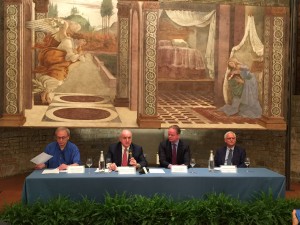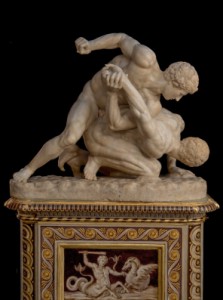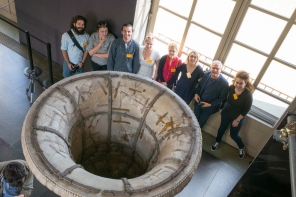A historic, inventive and inspiring collaboration
Call it the birth of a genuine Renaissance partnership.
Today marked the beginning of Indiana University’s weeklong trip to Italy and Poland, and one couldn’t have scripted a more momentous and inspiring way to inaugurate what promises to be a historic next few days in several of Europe’s oldest cities.

Indiana University President Michael A. McRobbie, second from left, announces a new partnership between IU and the Uffizi Gallery in Florence, Italy, which calls for IU to digitize, in 3-D, the museum’s entire collection of Greek and Roman sculpture.
Early this morning, under an already bright Tuscan sun, members of the IU delegation, led by President Michael A. McRobbie, traveled to the historic Uffizi Gallery in central Florence, Italy, one of the oldest and most renowned art museums in the world. Home to some of the finest masterworks of the Renaissance period in Europe, the Uffizi showcases works by, among others, Botticelli, Caravaggio, da Vinci, Fra Angelico, Michelangelo, Raphael and Titian. More than 1.5 million visitors pass through the museum’s galleries each year, making it the most visited museum in Italy.
The Uffizi collection contains 1,250 pieces of irreplaceable Greek and Roman sculpture, which are located at the gallery as well as the Pitti Palace and Boboli Gardens, two other famous cultural sites in Florence. The 1,250 works of art comprise the third largest collection of its kind in an Italian state museum. Largely assembled by the Medici family from the 15th to the 18th centuries, the sculptures include some of the most admired classical antiquities in the history of art, notably the Medici Venus, the Medici Faun, the Niobids and the Ariadne. Many of the Uffizi’s marble sculptures adorn the magnificent long corridors that outline the U-shaped second floor of the museum.
Just as they did during the time of the Renaissance, these ancient statues continue to attract the attention of all kinds of artists, including poets, painters and sculptors, who are able to find inspiration in their reflection of beauty, balance, harmony and superior craftsmanship.
Rebirth and recreation
Around midday today, the sculptures were the subject of a different type of attention, however, as members of the IU delegation were led to a most auspicious setting within the Uffizi complex to make a historic announcement: the former Church of San Pier Scheraggio.
Known as the “vanished church,” it was constructed in the eighth century on top of the remains of a second-century Roman temple. A Romanesque church was dedicated in 1068, and it began serving a central role in Florentine society, used not only for religious services but also city council meetings. In the main body of the church, during several important assemblies, the legendary Italian poets and scholars Dante, Boccaccio and Petrarca delivered orations to the people of Florence.

Lottatori, (wrestlers), first century B.C. Roman sculpture, is part of the Uffizi Gallery collection in Florence, Italy, to be digitized in 3-D.
Today, the remains of the church are on via della Ninna (the “lullaby” street), a small and shaded avenue that lies between the Palazzo Vecchio and the Uffizi Palace. Within the church, which is now considered one of the Uffizi Gallery exhibition rooms, there are several sculptures and paintings, including a triad of mural paintings honoring Dante, Boccaccio and Petrarca. But the crown jewel of the room is a fresco painted by the Renaissance master Sandro Botticelli. Beginning in the late 15th century, the fresco, titled “The Annunciation,” originally hung over the entrance of San Martino della Scala, a hospital situated in the main plaza of nearby Siena for those stricken with the plague.
Fittingly in this place of continual rebirth and recreation, and surrounded by the most famous figures of Florentine history, IU and the Uffizi jointly announced a historic collaboration that calls for the digitization, in 3-D, of the museum’s entire collection of ancient sculpture. The project between the Uffizi and IU’s Virtual World Heritage Laboratory will result in the creation of high-resolution 3-D digital models of the Uffizi sculptures, which will also be made freely available online by IU’s bicentennial in 2020.
The announcement of the digitization project was jointly made by McRobbie and Uffizi Director Eike Schmidt, who signed an agreement to carry out this unprecedented initiative. In his remarks at the announcement, McRobbie described the IU-Uffizi collaboration as “a historic and hugely ambitious project, one that will generate unparalleled opportunities for scholarly engagement with one of the greatest cultural institutions in the world and its legendary collections.
“Indeed, it would be nearly impossible to overstate the cultural and educational impact of this extraordinary and inventive collaboration,” he added. “IU’s scholarly expertise in ancient art and culture, as well as our technological expertise, will be leveraged to bring to virtual light a collection of classical antiquities that has inspired some of the greatest artistic geniuses in the history of Western art.”

A team from Indiana University and Milan Politechnic gather around a large Medicean vase being scanned to create a 3-D model. Second from right is Bernard Frischer, IU professor of informatics and director of the university’s Virtual World Heritage Laboratory.
The IU-Uffizi collaboration will be led by Bernie Frischer, IU professor of informatics, director of the university’s Virtual World Heritage Laboratory and one of the world’s leading virtual archaeologists. Frischer, who also spoke at today’s announcement, was one of the first academics to use 3-D computer modeling to reconstruct cultural heritage sites, and he has overseen a number of major modeling projects, most notably Rome Reborn, a virtual re-creation of the entire city of ancient Rome within the Aurelian Walls. In recent years, he has focused on digitization and digital restoration of ancient sculpture, as well as a 3-D restoration model of Hadrian’s Villa, one of the Roman Empire’s best-known and best-preserved imperial villas.
The five-year project between IU and the Uffizi will also include training IU informatics and art history students in the techniques of 3-D data capture, digital modeling and interactive online publication; creating a limited number of 3-D restoration models of works of sculpture of interest to individual project participants; and publishing the 3-D models on several online sites, including the Italian Ministry of Culture’s internal conservation database, the Uffizi’s public website and the Virtual World Heritage Laboratory’s publicly available Digital Sculpture Project.
A further goal of the project will be to launch a new collaborative relationship between the Uffizi and IU’s newly named Sidney and Lois Eskenazi Museum of Art that could include mutual loans of works of art, the development of temporary joint exhibitions and the creation of new virtual gallery tours. Indeed, plans are already underway for the first such project: the creation of a virtual-reality experience of the Tribuna, one of the Uffizi’s most important galleries.
The IU Mark Cuban Center for Sports Media and Technology, housed in IU Athletics, will collaborate on the Tribuna project, which is expected to be the first of a series of exhibitions at the Eskenazi Museum of Art using virtual reality technology.
As if the day hadn’t been memorable enough, following the announcement, members of the delegation received a special tour of the Tribuna room and its extraordinary contents, including the famed Venus de’ Medici sculpture and the Roman marble sculpture known as The Wrestlers. [The 3-D digitization work on the sculptures in the Tribuna will begin next week.]
Here, in the heart of the Uffizi, it was truly an honor and a privilege to experience these extraordinary works of art up close and personal. And even though we could’ve spent several more hours walking the halls of the Uffizi, all of us could look forward to the exciting possibilities of a truly historic, inventive and inspiring collaboration.
Related links:
Explore a 3-D image of Priestess, late first or early second century AD, in white marble
Explore a 3-D image of Tiberius, circa 14 AD, in Parian marble.
Tags: Bernie Frischer, Digital Sculpture Project, Eike Schmidt, Florence, Italy, IU Eskenazi Art Museum, Mark Cuban Center for Sports Media and Technology, Michael A. McRobbie, Uffizi Gallery, Virtual World Heritage Laboratory



